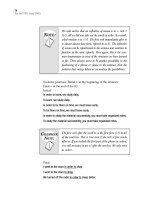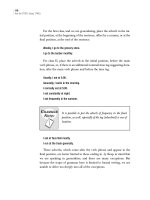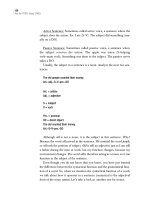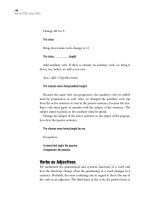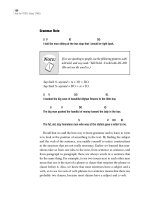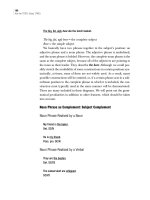Tài liệu Ace the toefl essay part 3 pdf
Bạn đang xem bản rút gọn của tài liệu. Xem và tải ngay bản đầy đủ của tài liệu tại đây (119.37 KB, 11 trang )
TOEFL Internals flowed
7/13/07
3:35 PM
Page 10
10
Ace the TOEFL Essay (TWE)
C. Your idea
D. Your idea
TR
¶ TS = 4 (His idea, reworded)
TS = S + V + Adj. + His idea
A. Your idea
B. Your idea
C. Your idea
TR
¶ Conclusion = Summing Up = Your Ideas
It is best to cut the preceding down to fit the necessary length requirement, perhaps even by 30% in the body.
Remember: We can always add to this, and we can always take away
from it.
Cause-Effect
In academia, the cause-effect pod is probably the most common, along
with the comparison-contrast. Look for words that suggest a connection
between items, words that link, such as cause, reason, effect, result, and lead
to. One can write short and long essay questions and term papers, as well
as combine the cause-effect with other pod(s) for longer projects. When
students complain to me that they cannot think of anything to write, I
always tell them to think of something they hate right this minute. That is
not so hard, because we all have something that really irritates us. If you
can think of something you hate, it is probably existent as you read this.
Think of how that thing developed into being. By tracing its development,
you have come up with half of the battle in a cause-effect pod. We must
be careful, however, that we do not have glitches or gaps in our logic. This
is the most common problem I, as a professor, read in the papers of my
students. To ensure that you don’t make these same mistakes, see the
chapter on logical fallacies. We also want to have a tight structure in
regard to the time link between the causal factors and the effect in our
paper. What do I mean by that? Do not try to explain the existence of
racism, its origin, the development over time, and the status of it now in
TOEFL Internals flowed
7/13/07
3:35 PM
Page 11
11
Essay Formats
the United States in a paper of only two pages. A task like that calls for
more space. Try to narrow the topic down. For example, you may want
to trace the rise in racism within a particular cross section of the United
States or the development of one motif of racism. When you narrow your
topic, your paper will be more credible. Further, you can concentrate on
a particular aspect you know more about to begin with. Mostly, though,
you avoid broad generalizations for which graders usually take off points.
Let’s continue to think about and include our ESs in the introduction.
These ESs will be the factors in a giant causal chain that runs through the
paper, all leading to the effect that we, the writers, thoroughly hate or
love—you decide. The effect should be in the thesis statement of your
introduction. Basically, we will work backward, beginning with the effect
and discussing the factors that lead to it. With this approach, the reader
does not have to search for the thesis of your paper, nor does he need to
wait until the end to discover what you truly think about the situation.
Keep in mind that you never want to lose the reader. You want to guide
him, but in order to do that you must keep him involved in the reading,
especially if the reader is your grader.
¶ TS = Effect (Intro.)
2. ES
3. ES ٌ
General to specific
TR = 1-2-3-4. This is the causal chain in order,
sufficing as the transitional sentence.
¶ TS = 2
Example
TR
¶ TS = 3
Example
TR
¶ TS = 4 (can put #4 with conclusion)
Value judgment
TR
¶ ⌬ Specific to general (Concl.)
TOEFL Internals flowed
7/13/07
3:35 PM
Page 12
12
Ace the TOEFL Essay (TWE)
We move back and forth from general statements to more specific
statements at the beginning, because we are describing a general effect of
that specific behavior. In the conclusion, we move from the specific to the
general, because the body has detailed the specific behavior that becomes
the causal factors.
The following introduction looks like this:
SAMPLE
TS = Effect
1-2-3-4
1 = ES 1
2 = ES 2
TR
Cause-Effect
Lifting weights can have a comprehensive effect on one’s wellbeing. One may very well experience an immediate difference in
endurance, leading to an increase in appetite, in turn fighting
off sickness through good diet, and culminating in marked levels
of strength. Often, beginners say they feel increased energy
throughout the day. The relationships between food, feeling, and
appearance are inseparable. In time, those same people love to
look in the mirror, because the positive gains are surely noticeable. This is information that certainly needs to be shared.
Lifting weights has so many positive results, but one that is
shocking to many people is how quickly a person improves his
energy levels. For instance, in as little as two weeks, the average
Joe can significantly increase his endurance. That means more
energy at the end of the day. As a result, he could take extra classes at night. A night workout schedule may also take form. Instead
of feeling wiped out after a day at work, one could engage in productive things such as community service or even volunteering to
help a friend. More important, by giving a little of oneself in the
gym, a person can experience a return on his investment that can
never be measured. Exercise affects not only endurance level
but also appetite.
TOEFL Internals flowed
7/13/07
3:35 PM
Page 13
SAMPLE
13
Essay Formats
When an athlete, or almost anyone for that matter, fuels his
body sufficiently and efficiently, his mind and body both reach new
levels of competence. The small, pesky cold no longer nags as it
did before those cleansing workouts, specifically because the
body is cleansed of impurities through life-sustaining nourishment. Antioxidants whisk away the toxins in one’s system. The
blood circulation, as a result, experiences higher levels of oxygen;
thus, one has more defensive ability. Hence, the body is hungrier
than before, and any fuel, accordingly, might be used to maintain
the system’s requirements. There is a direct link between exercise, eating, and health.
The single most significant milestone for many weight lifters is
the ability to make progress in lifting. Most men say that to look in
the mirror and see visible gains in muscle mass enhances their performance in the gym. Whether he is conscious of it or not, then, a
guy feels better about himself when he can put more weight on the
bar. It is no joke to surmise that all of the factors discussed herein
are inextricably wound up together in one way or another. The
more a guy lifts, the stronger he gets. The stronger he gets, the
more his body requires fuel. The more fuel he consumes, the
more his muscle mass increases. Then, he is drawn to the mirror,
and he sees progress with time. The more time he spends, the
more gains he sees. The cycle is certainly one big circle.
To have a program is a good idea. To obtain whatever goals
one has necessitates planning, commitment, and hard work. The
main factor to persistence, many times, is one’s ability to visualize
what comes next, even though the net result may not be readily
apparent. Diligence and visualization are the keys to implementing
the cycle of success.
A Note on Transitions
In the first paragraph in the body, I varied the transitions as to initial and
medial positions in the sentences. The transitional sentence at the end
looks back at the preceding paragraph and looks ahead at the next topic.
TOEFL Internals flowed
7/13/07
3:35 PM
Page 14
14
Ace the TOEFL Essay (TWE)
Paragraph two does exactly the same thing, but the transitional sentence
mentions the first two topics and links them to the third topic in the body.
Finally, I changed the method in the body’s last paragraph by focusing on
cleft sentences to draw attention through the rhythm of the sentences.
This suggests that all the elements influence each other. However, you can
add to this with a longer assignment, sprinkling it with longer examples,
real data, and even sources.
Comment: The cause-effect paper must have the links between points
(causes and the effect) practically weaved together. If written well, and
logically, the points will seem to naturally flow together. There will,
though, always be a spot where something can be picked apart. But, we
must remember that we are not writing a history or a pedagogical text in
the course of one paper. Coherence, moreover, is an important key in
anything one writes. If you are writing a scholarly piece, and you know
that there are other existing bodies of criticism, ones that stand in contention to what you think, that which you have espoused, it is common to
give a polite nod in your work; this suggests you are aware that many
opposing points of view are out there. Give only a polite nod, however.
The paper is yours, and do not feel obligated to delve into opposing arguments at any length unless your work is based on direct refutation of
another’s work.
What Types of Words to Employ
The audience plays a huge factor in determining the development of a
paper. Development of a paper includes the types of words the writer
employs; for instance, one may talk in abstract terms, or, if talking about
the destruction of property, one could use concrete language, calling it
vandalism—as opposed to a generalization like maladjusted behavior. Word
usage, commonly termed diction, is linked directly to the purpose of
the writer, which is certainly wrapped up with the reason why an audience exists in the first place. The same writer or speaker speaking to the
same exact audience on a different day about a different topic may use
completely different language than before, and this is due to the matter
discussed at the meeting and the purpose of the writer/speaker. If the
TOEFL Internals flowed
7/13/07
3:35 PM
Page 15
15
Essay Formats
writer/speaker wants to excite the emotions of his crowd, he will probably speak in emotive appeals. Emotive appeals, abstract language, concrete language, and descriptions all set the tone of the writing or speech.
Everything has a link, some sort of a glue that bonds them together. The
purpose of the writer, whom he talks or writes to, why, how, where, and
when all determine how things are bonded together. One could argue
that this occurs in different ways: the audience determines the approach
of the writer, and the purpose of the writer determines who his audience
is, and, vicariously, the diction and the tone fall into place from there.
The answer to that is subjective. If I am a college student, the audience,
my professor, determines the purpose of my writing: passing the course.
But, if I am a professional writer, I myself decide who my audience is
by choosing where I sell my work. We need to prepare ourselves to
write for different purposes, particularly seeing that a lifetime of writing
is ahead.
Audience, succinctly defined, includes anyone who is paying attention.
The person sitting at a stoplight, in the loosest of definitions, is the audience of that stoplight. We are the audience of billboards, commercials,
radio announcements, the nurse, the doctor, and family members. When
my attention is directed to a source for a brief instant, even unconsciously, I become an audience. Whether my attention remains fixed depends
on my purpose. Whether the source, if it is a person, of course, continues
to vie for my attention depends on his motivation. If he’s a pushy salesman or a beggar, most likely he’ll have a plan to keep me there and
maybe draw me closer. This plan, devised at that exact minute or with a
rehearsed format, is rooted in his goal. He has his goals, and I have mine.
They have to meet in order for ultimate success to occur. Take, for example, the beggar. If a guy is in a hurry, and he’s approached by the beggar,
the scene may play out as follows.
The businessman, late, glanced repeatedly at his watch. He stood
nervously at the corner, beaten by the whip of an arctic blast, waiting,
waiting for that stupid, incompetent bus driver, twelve minutes behind.
A haggard, broken, old homeless man about ten paces away limped
over, eyes fixed on the businessman at the corner, who by now was
shivering, staring at and tapping on his watch. The old man, the bushy,
dirty, old beggar, tapped the waiting passenger on the shoulder. The
TOEFL Internals flowed
7/13/07
3:35 PM
Page 16
16
Ace the TOEFL Essay (TWE)
businessman, caught unaware, turned suddenly, and the two stood
face-to-face. The beggar, surprised that he’d startled the man, stood
there and looked at the other, speechless. The businessman stepped
back and surveyed his face, taking in the cracks, the sullen eyes, the bits
of something that were caught in the old man’s beard, and the snot
around the nose. The old man lifted his hand, palms up, and started to
say something, but he began to cough instead. Behind him, the businessman heard the roar of a big engine and the screech of brakes. He
didn’t turn but remained in that position, just staring. A flake of snow
dropped on the businessman’s face. It was cold. The door of the bus
opened. The businessman turned and got on the step, but he stood
there, looking back. The old man never moved. He whispered a half
audible, “Please.” The businessman stepped down, walked over to the
man, grabbed his filthy hand, and then threw an arm around his shoulder. They looked at each other, and a world of apathy and a world of
bitterness dissolved in a matter of seconds. The younger said to the
older, “Let’s go get something to eat.”
Any method of saying something relates to diction. Authors are constantly scrutinized for their ability to say something and how they say it.
One uses flowery language, the other directs the reader with a pedantic
style, and another uses logic. Most people probably have an innate sense
of verbalizing their feelings. Certain people click by saying very little at
all. Ernest Hemingway has been heralded as the tough-guy writer who
conveyed volumes in his writings through short, choppy sentences. The
reader has to dig for the truth, a motif of twentieth-century modernist literature. This dig for the truth, as it is routinely called, involves looking
for symbols, for double meanings in the diction, and at how the sentences are structured, among many other elements. Similarly, the tough
guy on television rarely says much. Think of some actors. Chuck Norris,
Jean Claude Van Damme, and Sylvester Stallone rarely get into long conversations. Of course, some tough-guy characters do, like Bruce Willis
with his humor. Depending on the purpose and the particular approach
one uses to convey his ideas, elaboration may or may not be appropriate. Hypothetically, if I write about gang violence in the local neighborhood, and I relate the story of the death of a five-year-old girl, I would
definitely describe how her little, innocent body was brutally torn apart
TOEFL Internals flowed
7/13/07
3:35 PM
Page 17
17
Essay Formats
and how the gangsters laughed raucously as they sped away. Why? I
want the public to know the putrid, hateful, callous behavior that takes
place so frequently. These types of descriptions would involve very
graphic detail with concrete language. On the other hand, descriptions of
moral issues include abstract, intangible, untouchable things, because
morality is abstract. Certainly, some topics allow the integration of the
two. Most of the things we read have an integration of sorts. Again,
everything depends on the purpose of the writer and for whom he is writing. The writing style, degree of elaboration, word choice, and syntax
reflect on the tone.
The tone is the attitude the reader has toward the writer, perceived
only by the author’s written word. It may be wrong or misinterpreted, but
it is valid. A child says something to be funny, but the parent takes it as
insubordination. This is a perfect example of why choosing the correct
words is so important. An author may write in short, choppy sentences
throughout a piece and, at the end, discuss the immorality of something
very minor in a long, complicated structure. One could interpret this style
and the writer himself two ways. He is viewed as condescending or genuinely concerned. His point strikes home if he is read with understanding,
but, if not, his attempt is futile. Consequently, one should keep the same
style all the way through the text. If changing style is absolutely necessary,
using appropriate diction will ensure that the change is evident to the
audience. Sudden changes often disorient the audience. Although the
structural patterns, topics, and transitional sentences are in order, it takes
only one paragraph to tear down all the progress achieved.
Summing up, it is obvious that writers influence the audience and vice
versa. Whatever the situation, the style of writing is set by the ideology
and demographics of the audience. The aim of the writer dictates what
tools he works with, such as diction, structure, pods, and the tone that
shines through the finished product. All of these elements are inextricably
connected. A relationship exists between every one of them. In the final
analysis, the combinations are limitless, and only the writer knows exactly where he wants to go. You have a very simple rule to follow: write
about abstract things in very concrete examples.
The extended definition paper uses abstract diction and concepts quite
frequently.
TOEFL Internals flowed
7/13/07
3:35 PM
Page 18
18
Ace the TOEFL Essay (TWE)
Extended Definition
Look for words such as call, appear to be, seem like, act like, define, say that,
and may possibly be. This pod prepares you for a lot of questions that deal
with other people’s opinions. It is called an extended definition because it
adds to the generally accepted definition of a thing. Look for sentences
that begin with “Some people say….” Look over the pod(s). The transitions are the same guiding light for your TOEFL grader.
¶ TS = General Definition + your idea (Compound Sent.)
1. ES
2. ES
TR
¶ TS = 1. Reworded
ٌ
Example
TR
¶ TS = 2. Reworded
ٌ
Example
TR
TR
¶⌬
Concluding statement
Another Definition Paper
¶ TS = General Definition + your idea (Compound Sent.)
1. ES Note: 1–3 can be facets of your idea; thus
2. ES the paragraphs in the body don’t require an
3. ES ex. in each. They can be replaced by comparisons
TR and contrasts.
TOEFL Internals flowed
7/13/07
3:35 PM
Page 19
19
Essay Formats
¶ TS = 1. Reworded
ٌ
comp-cont
TR
¶ TS = 2. Reworded
ٌ
comp-cont
TR
¶ TS = 3. Reworded
ٌ
Example
TR
¶ ⌬∆
Concluding statement
SAMPLE
The next paper follows this pod. Everything is always interchangeable.
These are guidelines to follow, like a workout routine. They are not written in stone. When we think in patterns, we can see writing and grammar
as sets of patterns and not only as a group of words to grapple with.
Extended Definition
Most people think compassion is feeling sorry for others when
times are bad, but true compassion is feeling the pain of another
individual. Empathy is the true earmark that separates the majority of those who see the pain of another and those who feel the
pain of another. Sharing the burden of a friend when life is so
heavy demonstrates empathy. Consistency lingers on in those
who feel that friend’s pain. A closer look will reveal the differences
in what most people think and a few actually know.
Placing oneself in another’s spot is difficult, especially if one
can only imagine how bereft the other feels. Suffering the death
of a child is a prime example. When a person outlives his own
child, an intolerable heaviness pervades every breath. It is easy to
engage in idle conjecture, offer consolatory remarks, and even
extend a hand in friendship. Often, we watch older people endure
TOEFL Internals flowed
7/13/07
3:35 PM
Page 20
SAMPLE
20
Ace the TOEFL Essay (TWE)
the loss of a spouse, and we feel sad, because they are acquaintances or family. After the funeral, we go our own way, with a pat
remark, often sincerely given, and we go home, kick our feet up,
and forget. Across town, Martha is wandering aimlessly, hearing
Fred’s voice, but he is not actually there. But Martha’s friend, who
buried her husband three months earlier, feels the pain all over
again as she slips into bed. She can feel that same exact pain,
because she suffered the same exact loss. She has been there.
Martha’s daughter does not feel like Martha does, because she
lost a father, whereas Martha lost a lifelong partner. The pains are
not equal. The people who only see the pain and feel sorry for the
bereaved whisper to themselves, deep in their hearts, that Martha
should move on. But the one who suffered the same pain tries to
be near the phone and help out in any way possible.
To take the weight eases the load in a time of tragedy. Helping
out hurting people is good, but they need more than that. To actually step under the burden means more than giving a hand. Only
the bereaved can feel that complete loss at that exact time, but
shouldering the responsibility means paying bills, buying groceries, setting appointments, and tending to things never thought
of by those who watch from the outside. Sharing the burden is to
actually live through part of the pain, even taking more than could
ever be expected. It lightens the weight that virtually crushes the
life out of someone with such a loss. Taking that responsibility
transcends the menial tokens, the gestures, offered from duty,
done in public, and displayed in formality. In contrast to duty, love
is continuous, and the majority sleep when the knowledgeable
attend to the burden of their friend.
Veterans of death, divorce, and other life-shattering events usually continue to help others, the victims, until they see the strength
start to return. Most people never understand, at least until they
go through it, the lingering effect of such catastrophes. But the
ones who went through it do, and they are usually the ones to
count on in the midst of sorrow. Day after day, these same faces
drop by, bring things, go to the store, and go to the post office.
They realize how physically debilitating sorrow is. For example, it
